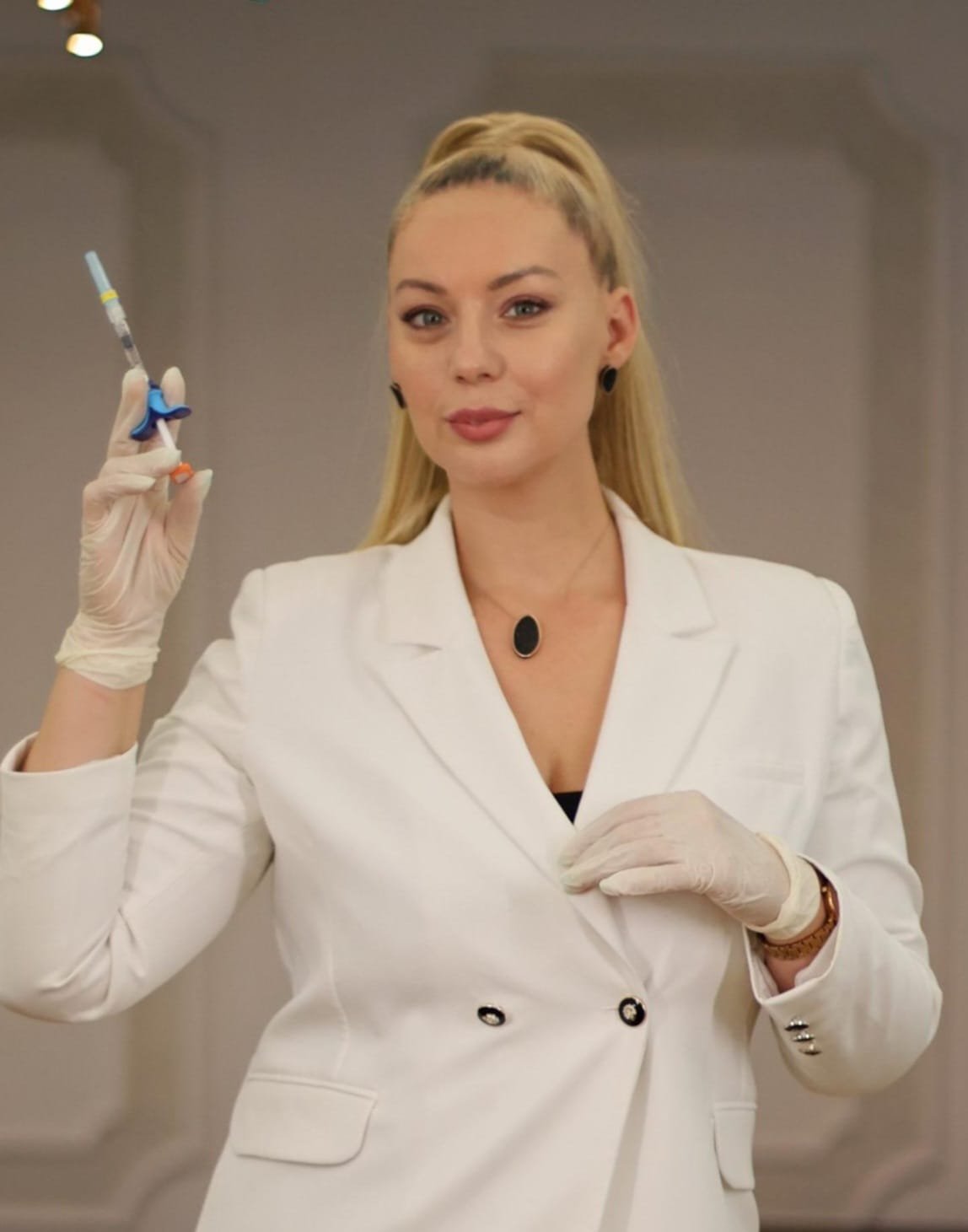Ce se întâmplă cu pielea în timpul procesului de tatuare?
- Tatuarea presupune injectarea de cerneală în derm prin intermediul acelor sterile. Aceste ace penetrează pielea și introduc pigmentul în profunzime, ceea ce permite ca desenele să rămână permanente.
- În acest proces, pielea reacționează la microtraume, iar sistemul imunitar este alertat, generând o reacţie inflamatorie inițială. Aceste răspunsuri sunt normale și reprezintă primul pas în procesul natural de vindecare al corpului.
- Reacţia pielii imediat după tatuare: pielea devine roșie, umflată și sensibilă.
Aceste semne indică faptul că organismul începe să repare micile leziuni create de ac. De asemenea, se poate observa o ușoară sângerare sau exudat, ceea ce este normal în primele ore după procedură. Inflamația și iritația sunt parte a răspunsului natural al pielii la stresul mecanic și la prezența pigmentului străin.
Cum se face corect îngrijirea tatuajelor? Pași esențiali
Îngrijirea unui tatuaj proaspăt, imediat după realizarea lui
După ce ai făcut un tatuaj, pielea este sensibilă și vulnerabilă la infecții.
lată pașii esențiali pentru o vindecare rapidă și sigură:
- Curăţarea delicată: Spală zona tatuată cu un gel de curățare blând, fără parfum, precum Lipikar Syndet AP+ de la La Roche-Posay, care ajută la calmarea pielii și la prevenirea uscării excesive.
- Hidratare intensivă: Aplică o cremă reparatoare, cum ar fi Cicaplast Baume B5+, care accelerează regenerarea pielii tatuate și calmează iritațiile cu ajutorul formulei sale complexe. Balsamul conține pantenol 5% și Madecassosidă care stimulează repararea pielii, alături de ingrediente active ce promovează sănătatea microbiomului pielii și unt de shea pentru ultra-hidratare.

- Evitarea expunerii la soare: Razele UV pot decolora tatuajul și pot irita pielea. Folosește un protector solar, dar și cicatrizant, pentru a preveni decolorarea și iritațiile. Noua cremă pentru vindecarea tatuajelor, Cicaplast B5+ cu SPF 50 îți asigură ambele beneficii.
În cât timp se vindecă un tatuaj?
Vindecarea unui tatuaj durează, în medie, între 2 - 4 săptămâni și este împărțită în trei etape:Etapa inițială – primele 48 de ore:
În primele două zile, pielea tatuată se află în faza de inflamație acută. În această perioadă, este important să se evite atingerea directă a zonei tatuate și să se păstreze zona curată.Etapa de regenerare - zilele 3-10:
Pe măsură ce inflamația scade, pielea începe să se regenereze. În această etapă, se formează o crustă subţire, iar pielea tatuată poate părea uscată sau chiar puțin descuamată. Este esențial să nu se smulgă crustele, deoarece acest lucru poate afecta aspectul final al tatuajului și poate favoriza apariția cicatricilor.Etapa de vindecare a tatuajului – după prima săptămână:
După aproximativ o săptămână, pielea se vindecă mai profund, însă regenerarea totală poate dura între 3 și 4 săptămâni. Chiar dacă tatuajul arată normal la suprafață, procesul de vindecare continuă la nivel celular, în profunzimea pielii.
În această perioadă, hidratarea constantă și aplicarea produselor cu SPF sunt esențiale pentru a menține claritatea și intensitatea culorilor tatuajului.
Perioada de vindecare a tatuajelor: Ce să faci și ce să eviţi
Pielea începe să se refacă în primele săptămâni, iar tu trebuie să ai grijă pentru a evita complicațiile.
✔ Ce să faci:
- Hidratează zona tatuată zilnic pentru a preveni uscarea și descuamarea excesivă.
- Poartă haine largi din bumbac pentru a evita frecarea și iritațiile.
- Spală-ți mâinile înainte de a atinge tatuajul pentru a preveni infecţiile.
X Ce să eviți:
- Nu scărpina sau decoji pielea exfoliată, deoarece acest lucru poate afecta pigmentul.
- Evită piscinele, saunele și băile lungi, deoarece umiditatea excesivă poate încetini vindecarea.
- Nu aplica produse pe bază de alcool sau parfum pe zona tatuată, deoarece pot irita pielea.
Îngrijirea tatuajelor pe termen lung
Pentru a păstra aspectul impecabil al tatuajului ani de zile, este esențial să menții pielea hidratată și protejată.
- Hidratează zilnic – Aplică Cicaplast Baume B5 pentru a menține pielea elastică și a preveni descuamarea.
- Exfoliază delicat– O dată pe săptămână, o exfoliere blândă ajută la îndepărtarea celulelor moarte şi menţine intensitatea culorilor.
- Protejează-te de soare pe tot parcursul anului – Chiar și în sezonul rece, pielea tatuată are nevoie de protecție solară pentru a preveni decolorarea.
Un aspect esențial al îngrijirii tatuajelor este protecţia solară. Cicaplast Baume B5+ SPF 50 joacă un rol important în acest sens, deoarece oferă protecţie sporită împotriva razelor UV și contribuie la menținerea integrității pielii în timpul procesului de vindecare. Acest produs nu doar că ajută la prevenirea decolorării tatuajului, dar și la reducerea riscului de iritații și arsuri solare, care pot compromite atât estetica, cât și sănătatea pielii tatuate.
Cum îți protejezi tatuajul de efectele nocive ale soarelui?
Aplică protecţie solară cu SPF ridicat
- Folosește Cicaplast Baume B5+ cu SPF 50, o cremă reparatoare care combină efectul calmant și regenerant al produsului Cicaplast Baume B5+ cu o protecție solară avansată împotriva razelor UVA/UVB. Acesta previne hiperpigmentarea, decolorarea tatuajului și iritațiile pielii cauzate de expunerea la soare.
- Reaplică la fiecare 2 ore– Mai ales în sezonul cald, tatuajele expuse trebuie protejate constant.
- Evită soarele în primele 3-4 săptămâni– Dacă tatuajul este într-o zonă expusă, poartă haine din bumbac pentru protecție suplimentară.
Concluzie
Tatuajele sunt opere de artă care necesită o îngrijire atentă atât în timpul, cât și după procedură. În această perioadă, menținerea igienei, hidratarea corespunzătoare și protejarea împotriva factorilor externi, în special a radiațiilor UV, sunt esențiale pentru a asigura o vindecare optimă și pentru a păstra frumusețea tatuajului.
Utilizarea produselor din gama Cicaplast de la La Roche-Posay, Cicaplast Baume si Cicaplast Baume Spf 50+, se dovedește a fi un aliat de nădejde în această misiune, oferind nu doar protecție solară, ci și ingrediente care accelerează regenerarea pielii și ajută la repararea barierei cutanate.
Află mai multe despre protejarea barierei cutanate prin folosirea de creme pentru iritații și mâncărimi.

Autor:
Dr. Cristalia Rusu-Doriza, Medic primar dermatovenerolog





